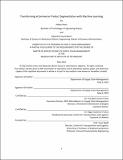| dc.description.abstract | Inventory management is one of the key elements of supply chain management for any organization to manage costs versus service level tradeoffs. Product segmentation for inventory is therefore a key lever for inventory management. Traditionally, this segmentation is done using only a single criterion. This paper presents a framework that uses a hybrid approach combining a multi-criteria decision-making technique, analytical hierarchy process, and machine learning algorithms, support vector machines and artificial neural networks, to improve product segmentation using multiple criteria as opposed to single criteria. Our results show an addition of 20-30% SKUs that should be in ‘A’ class that wouldn’t have been classified as ‘A’ products using a univariable approach. The machine learning models show an accuracy of 92.3% for linear SVM and of 86.5% for ANN with 8 nodes, with linear SVM outperforming ANN. Hence, our work demonstrates that using a hybrid model with AHP and SVM results in a flexible and customizable segmentation model that is highly beneficial for any rapidly growing company with a heterogenous product portfolio and can serve to increase the service level as well as decrease inventory costs for companies. | en_US |
